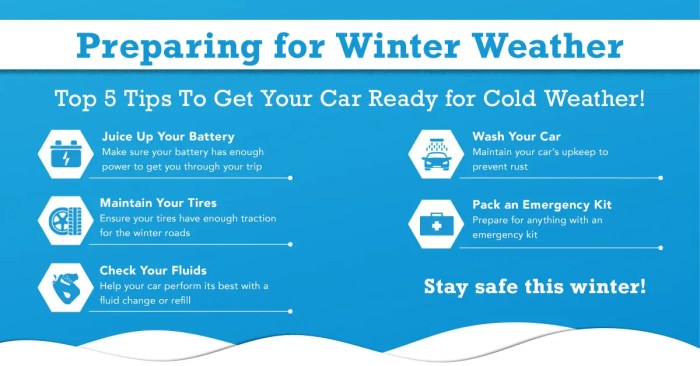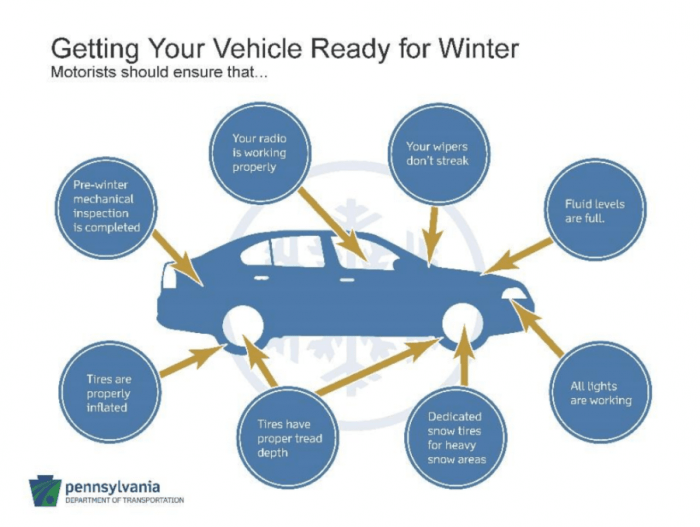How to Get Your Car Ready for Winter sets the stage for ensuring your vehicle is well-prepared for the upcoming cold season. From exterior maintenance to emergency kits, this guide covers all the necessary steps for a safe and smooth winter driving experience.
Whether you’re a seasoned driver or new to winter conditions, these tips will help you navigate the challenges that come with colder weather.
Preparing Your Vehicle Exterior
Before the winter season arrives, it is essential to take the necessary steps to prepare your car’s exterior. This will help protect your vehicle from the harsh weather conditions and prevent damage.
Washing Your Car
- Washing your car before winter is crucial to remove any dirt, salt, and grime that has accumulated on the exterior. These substances can cause corrosion and damage to the paint if left untreated.
- Make sure to clean the undercarriage as well, as this area is particularly vulnerable to salt and debris buildup.
Applying a Protective Wax Coating
- After washing your car, consider applying a protective wax coating to create a barrier against the elements.
- A wax coating helps to repel water, snow, and ice, reducing the chances of rust and corrosion on your vehicle’s exterior.
- Regular waxing can also keep your car looking shiny and new despite the harsh winter conditions.
Checking and Maintaining Tires

Maintaining proper tire pressure and condition is crucial for safe winter driving. Neglecting your tires can lead to reduced traction, longer braking distances, and an increased risk of accidents.
Importance of Checking Tire Pressure
- Regularly check tire pressure using a tire pressure gauge.
- Proper tire pressure ensures optimal traction on icy and snowy roads.
- Underinflated tires can lead to decreased fuel efficiency and uneven wear on your tires.
- Overinflated tires can reduce traction and increase the risk of blowouts in cold temperatures.
Winter Tires vs. All-Season Tires
- Winter tires are specifically designed for cold weather conditions, providing better traction on snow and ice.
- All-season tires are a compromise between winter and summer tires, offering adequate performance in various conditions but not optimized for extreme winter weather.
- Winter tires have a deeper tread pattern and softer rubber compound, allowing them to remain flexible in freezing temperatures.
- Switching to winter tires can significantly improve your vehicle’s handling and braking on snow-covered roads.
Inspecting Tire Tread Depth
- Use a tread depth gauge to measure the depth of the tire tread.
- Check for uneven wear patterns, bald spots, or signs of damage that could affect traction.
- Winter tires should have a minimum tread depth of 6/32 of an inch for adequate grip on snow and ice.
- Replace tires that do not meet the recommended tread depth to ensure safe winter driving conditions.
Ensuring Proper Fluid Levels: How To Get Your Car Ready For Winter

When preparing your car for winter, it is essential to check and top up various fluids to ensure optimal performance and safety during the colder months.
Essential Fluids to Check and Top Up:
- Engine Oil: Ensure the oil level is adequate and top up if necessary to keep the engine properly lubricated.
- Antifreeze/Coolant: This fluid is crucial for preventing the engine from freezing in cold temperatures. Check the levels using the dipstick or coolant reservoir and top up if needed.
- Brake Fluid: Inspect the brake fluid level and top up if it is below the recommended mark to maintain braking efficiency.
- Power Steering Fluid: Verify the power steering fluid level and add more if required to keep the steering system functioning properly.
Importance of Antifreeze and How to Check Levels:
Antifreeze, also known as coolant, is vital for preventing the engine from freezing and overheating. It helps regulate the engine’s temperature and protects it from corrosion. To check the antifreeze levels, follow these steps:
- Make sure the engine is cool before opening the coolant reservoir.
- Locate the reservoir and check the fluid level against the markings on the side of the container.
- If the level is low, add a mixture of antifreeze and water in the recommended ratio specified in your vehicle’s manual.
- Securely close the reservoir cap after topping up the antifreeze.
Using Winter-Grade Washer Fluid:
During winter, it is crucial to use a winter-grade washer fluid that can withstand freezing temperatures. Winter-grade washer fluid contains antifreeze agents, which prevent the fluid from freezing in the reservoir and on the windshield. Regular washer fluid may freeze and cause visibility issues, so always opt for the winter-grade version to ensure clear visibility while driving in cold weather.
Checking the Battery and Electrical System

When preparing your car for winter, it’s crucial to pay attention to the battery and electrical system. Cold weather can have a significant impact on these components, making it essential to ensure they are in good condition.
Checking the Battery’s Health and Connections, How to Get Your Car Ready for Winter
- Inspect the battery for any signs of corrosion or leakage.
- Use a multimeter to check the battery’s voltage to ensure it is within the recommended range.
- Tighten any loose connections and clean the terminals to improve electrical conductivity.
Impact of Cold Weather on the Battery
- Cold temperatures can reduce the battery’s ability to provide power, leading to starting issues.
- Extreme cold can also cause the battery to freeze, potentially damaging its internal components.
- Regularly checking the battery’s health before winter can help prevent any unexpected failures.
Importance of Checking Lights, Signals, and Heating Systems
- Ensure all lights, including headlights, taillights, and turn signals, are working properly for visibility in dark and snowy conditions.
- Test the heating system to ensure it can keep you warm during cold winter drives.
- Check the windshield wipers and defroster to maintain clear visibility in snowy or icy weather.
Preparing an Emergency Kit

When preparing for winter driving, it’s crucial to have an emergency kit in your car. This kit can provide you with essential items to help you stay safe in case of an emergency on the road.
- Blankets: In cold weather, blankets can help keep you warm if you’re stranded or waiting for help.
- Food: Non-perishable snacks like granola bars or nuts can provide you with sustenance if you’re stuck for an extended period.
- Flashlight: A flashlight can help you see in the dark and signal for help if needed.
- Charged Phone: Make sure your phone is fully charged before your trip and keep a car charger handy to stay connected in case of an emergency.
- Emergency Contact Information: Having important phone numbers, such as roadside assistance or family members, can be crucial in getting the help you need quickly.
Ending Remarks

In conclusion, taking the time to prepare your car for winter can make a significant difference in your safety and comfort on the road. By following these guidelines and staying proactive, you’ll be ready to tackle whatever winter throws your way. Stay safe and enjoy the season!